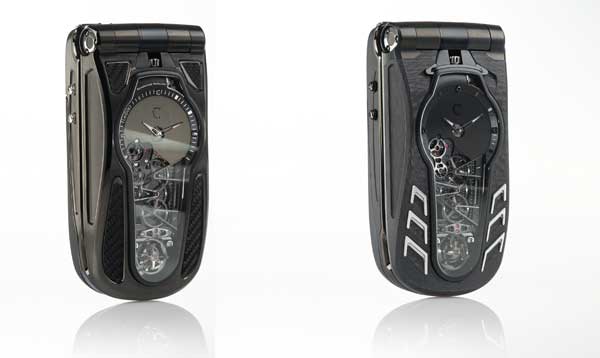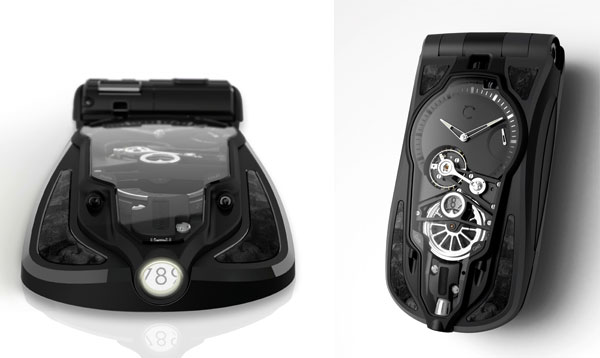
LeDIX véloce (left)
Case: Black PVD-treated grade 5 titanium structure with carbon fiber inserts, high-end watchmaking finishes (polishing, satin-brushing, Clous de Paris hobnail pattern,shotblasting) Size: 100x50x29 Movement: hand-wound mechanical movement (100h power reserve, patented system whereby each opening and closing of the clamshell phone generates an additional 3 hours of power reserve), flying tourbillon visible on both sides (world’s most off-centred tourbillon : 36 mm), regulating organ mounted on shock-absorbers, movement integrated within water-resistant case in aluminium treated with GL coating of titanium and ceramics, 333 mechanical parts (700 in all) Functions: clamshell mobile phone, mechanical battery-ejection system, patented mechanical hinge (Remontage Papillon), multi-lingual interface (including : French, English, Chinese, Russian, Spanish, Arabic), photo, video
Limited edition: 18 pieces
LeDIX Furtif (right)
Case: Carbon fiber structure with sapphire crystal featuring platinum inserts (or black or pink gold) Size : 100x50x29 Movement: hand-wound mechanical movement (100h power reserve, patented system whereby each opening and closing of the clamshell phone generates an additional 3 hours of power reserve), flying tourbillon visible on both sides (world’s most off-centered tourbillon : 36 mm), regulating organ mounted on shock-absorbers, movement integrated within water-resistant case in aluminium treated with GL coating of titanium and ceramics, 333 mechanical parts (700 in all)
Functions: clamshell mobile phone, mechanical battery-ejection system, patented mechanical hinge (Remontage Papillon), multi-lingual interface (including : French, English, Chinese, Russian, Spanish, Arabic), photo, video Limited edition: 24 pieces (3 x 8 pieces)
With the world’s most off-centered flying tourbillon equipping its LeDIX nomadic communication device, the Celsius X VI II brand is laying a new milestone in the history of mechanical horology. At once an archetypal model and an outsider in the field of new Haute Horlogerie, its “pocket-watch” heralds a new era at the peak of the luxury pyramid. To what goal does Celsius X VI II ultimately aspire ? To enable its micromechanical gem to become the first entirely mechanically autonomous cellphone of which all functions would be driven exclusively by human energy.
Since 2006, the founders of Celsius X VI II are doing everything in their power to pursue this aim, annually reaching new heights in their quest for the Holy Grail of mechanical autonomy. After four years of research and development, they have succeeded in developing a system generating three additional hours of power reserve after each opening of LeDIX in order to power its flying tourbillon – itself protected by suspension shock-absorbers. The foundation of this humanistic vision, that is drawing ever closer to fulfilment, lies in the patented “Remontage Papillon” mechanical-hinge winding system that has already won over the world’s most renowned collectors. How could one indeed fail to be impressed by the pure lines of this objet d’art and high-tech compendium that accompanies its owner in his travels ? Its 700 mechanical components (including 330 for the movement alone), majestically staged in a combination of titanium and carbon, go so far as to produce the characteristic “melodious tune” of cutting-edge micromechanical engineering – even when it comes to mechanically ejecting the phone battery. After LeDIX Origine and LeDIX Véloce, a third limited series named LeDIX Furtif (see next page) has been introduced in 2012, while a new generation of Celsius X VI II models is in the pipeline for the coming winter, and the next is already scheduled for Baselworld 2013. Once again, LeDIX Furtif is surrounded by a whole universe of exclusive and innovative accessories : a docking station in high density resin, a micromechanical chain lanyard, and a hands free kit in leather and satin-brushed steel.
This encounter between two worlds, those of Fine Watchmaking and telecommunications, stemmed from an encounter between three men, themselves each of different origins. In pooling their skills and their respective competencies, they shared a vision and convinced a panel of professionals recognised in their respective sectors to support them in achieving this world first. The three of them define the foundations of their philosophy in the following terms. For Romaric André, the motto is ‘Humanize’ : “Celsius X VI II is a family. We all share the same passion and it is reflected in the attachment we feel for each and every detail of our creations. Each product is a piece of art because of the human touch in every aspect of the creative process, from the first drawings by Thomas to the final assembling and testing by our engineers.” For Edouard Meylan, the key word is ‘Innovate’. “We’ve lost count of the number of times people have said : ‘A micromechanical phone ! Are you insane ?’ But what is true innovation without craziness?” Finally, for Thomas Pruvot, the guiding theme is ‘Dream’: “Welcome to the innovative world of Celsius X VI II, a world created out of a dream, because not everything has to be rational.”
LeDIX Origine
Case: Grade 5 titanium structure with ebony wood inserts, high-end watchmaking finishes (polishing, satin-brushing, Clous de Paris hobnail pattern,shotblasting) Size: 100x50x29 Movement: hand-wound mechanical movement (100h power reserve, patented system whereby each opening and closing of the clamshell phone generates an additional 3 hours of power reserve), flying tourbillon visible on both sides (world’s most off-centred tourbillon : 36 mm), regulating organ mounted on shock-absorbers, movement integrated within water-resistant case in aluminium treated with GL coating of titanium and ceramics, 333 mechanical parts (700 in all) Functions: clamshell mobile phone, mechanical battery-ejection system, patented mechanical hinge (Remontage Papillon), multi-lingual interface (including : French, English, Chinese, Russian, Spanish, Arabic), photo, video Limited edition: 18 pieces
A stealthy reference to the first arts
Clearly inspired by the stealth technology featured in high-performance aircraft, LeDIX Furtif is the very first cellphone with a carbon fiber structure. This sturdy and light instrument exudes an energetic and powerful personality. The creation of this prestigious nomadic object called for the combined intervention of 35 people including engineers, watchmakers and other artisans. LeDIX Furtif, which made its world-first appearance at Baselworld 2012, bravely defies conventions while evoking the secret dream we all have of making our own rules. It is determined to instil emotions at the heart of communications and to make a bold move on behalf of creative freedom. This is especially significant when considering that 2012 is the year when the art of time measurement is being raised to the status of 12th art by a community of passionate enthusiasts, with GMT resolutely on the front lines. While the 7th art (cinema) is the best known of the 11 first arts so decreed by means of various initiatives, the six first arts remain the most universal since they were first listed in the famous lectures on aesthetics given by the 19th century German philosopher Hegel: architecture, sculpture, painting, music, poetry and dance. LeDIX Furtif pays tribute to the 1st and 2nd Arts, as well as to the 4th and 5th Arts. The approach adopted by Celsius X VI II is imbued with poetry, and the musical tone of the astonishing nomadic object also stems from research specifically undertaken by the brand in collaboration with Le Tone, a Parisian artist who helped to create the mechanical-sounding tune that proves so truly unique.





